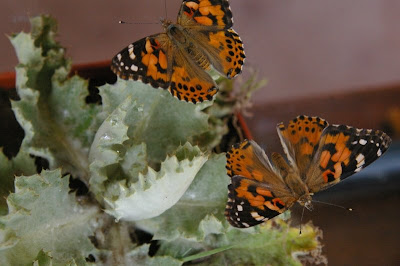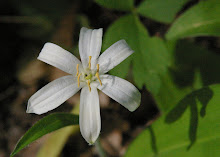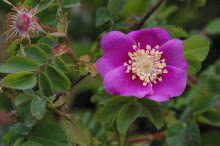
You might want to take a peek a Forest Zoo's blog. He's been posting like crazy today and has two posts from a second grader's perspective on our butterflies and the four stages of a butterflies life.
Tuesday, April 29, 2008
We have Caterpillar Babies!
Arranged at
8:27 PM
1 bouquets of wildflowers (Comment here)
![]()
Varieties: butterflies, homeschool, nature, science
Ordering Caterpillars
A couple people have asked me where we got our caterpillars from. I can tell you, but I know they are not the only supplier of caterpillars. We chose Painted Ladies, because they live around here and I knew they could get their favorite foods. Monarchs and Swallowtails are available also from some companies, but their life cycle isn't as quick.
We ordered a kit of 5 - 8 caterpillars with food and a growing cup from Butterflies and Blueberries. We didn't order a net cage, as we had an aquarium that we could keep them in once they hatched. But I just read another web page with directions on make a butterfly house out of a cardboard box. It also has more information about raising butterflies.
Another reputable place I know you can get caterpillars is Carolina Biological Supply. It is where teachers order science supplies for their classrooms.
We really have enjoyed our butterfly experience and I highly recommend it to any family. It is a great way to learn about life, with a minimal expense.
Arranged at
12:14 PM
0
bouquets of wildflowers (Comment here)
![]()
Varieties: butterflies, homeschool, science
Eggs Changing Colors

I also learned that one Painted Lady can lay up to 500 eggs! I don't think we have that many, but they are so tiny, I might be surprised.
Arranged at
10:46 AM
0
bouquets of wildflowers (Comment here)
![]()
Varieties: butterflies, homeschool, nature, science
Monday, April 28, 2008
Painted Ladies Love Dandelions
Forest Zoo helped me photograph some of our flutter babies today. He provided dandelion delivery services. Then he put a butterfly on a dandelion and held it in the light for me, so I could move in close and capture some of the beauty of creation seen in a Painted Lady butterfly. Most of the time we just don't get a chance to look at a butterfly closely. If we do it is a special moment. Usually they are off to bounding off to better buttercups in a blink.
Our butterflies are so tame. They don't mind being close to us at all. They enjoyed the fresh dandelions so much they hardly paid any attention to how close I was putting my lens to their face.
The sunlight was just right, lighting up the butterfly, and the macro lens blurred out the background, so you can't see any kitchen chairs or dishes in the china cabinet. See the little white knots on the end of their antenna. I hadn't noticed them before until I started looking at the photographs I had taken today. Learning to look close enough to really see is an art.



Arranged at
10:11 PM
7
bouquets of wildflowers (Comment here)
![]()
Varieties: butterflies, homeschool, nature, pets, wildflowers
Painted Lady Eggs

We have learned that it takes 5 - 10 days for the caterpillar to emerge from the egg. Just before it hatches it changes to a dark color. We are estimating that we should have baby caterpillars sometime between Thursday and Tuesday.
Arranged at
9:01 PM
2
bouquets of wildflowers (Comment here)
![]()
Varieties: butterflies, homeschool, nature, pets
We've got eggs!
We've got eggs! (I've got photos of them, but can't download them, because that computer isn't working today.) One day after we brought the thistles to our butterflies, the gentlemen started visiting with the ladies, if you know what I mean. The next day little blue/green dots started appearing on our thistle leaves. The eggs are about the size of a pin poke. Some were even laid on the orange slices we have put in with the butterflies. The Painted Ladies really seem to enjoy orange juice. And they love Dandelions! I've been viewing them up close with my macro lens and will have some interesting photos for you, as soon as my computer is working again.
The sad part of metamorphosis has started to take place though. Our first butterfly has died.
Arranged at
10:48 AM
2
bouquets of wildflowers (Comment here)
![]()
Varieties: butterflies, homeschool, nature, pets
Friday, April 25, 2008
Thistles for Our Ladies



Arranged at
9:35 AM
8
bouquets of wildflowers (Comment here)
![]()
Varieties: butterflies, homeschool, nature, pets, science
Bear Paw Quilt Being Tied



For more Sew Crafty fun, see Shereen's blog.
Arranged at
9:19 AM
4
bouquets of wildflowers (Comment here)
![]()
Varieties: quilting, Sew Crafty Friday
Wednesday, April 23, 2008
Butterfly Science
Forest Zoo and I have been studying insects for science. We ordered some Painted Lady Caterpillars. They arrived a few days after the beginning of April, and were quite tiny. They were inside a shallow cup eating food as fast they could. We followed the directions and left them in the small cup until they were larger then 5/8th of an inch long. Then we were to put some food in a larger cup and transfer the caterpillars to the new cup. They grew amazingly fast in the new cup.


Monday morning shortly after getting up I found the first butterfly had hatched. That changed the course of the whole day. When ever would school be so interesting! We transfered the chrysalis to a large aquarium we own, so they would have room to move around. We added some flowers and sticks to sit on. We had plans for regular homeschool, but all we could do was sit there and watch the butterfly, and his brother's hatch. It was amazing! They come out of the chrysalis so quickly, you really have to pay attention to see the whole thing.
I think this is one of my favorite science projects we have ever done. It was as exciting for me as watching a baby be born.
Painted Lady Butterflies are very beautiful! All seven of our babies hatched.
Arranged at
1:18 PM
4
bouquets of wildflowers (Comment here)
![]()
Varieties: butterflies, homeschool, nature, pets, science
CeCe the Cantalope Cat
Now that CeCe is pregnant she has taken to eating some new kinds of foods. Dry cat food will do, but if there is cantaloupe available, she'll be glad to clean off your rinds.
Arranged at
1:08 PM
3
bouquets of wildflowers (Comment here)
![]()
Varieties: pets
Pink Tulips for Sister

Then just before he darted outside again, he hurriedly whispered to her, "I love you."
Arranged at
8:43 AM
3
bouquets of wildflowers (Comment here)
![]()
Tuesday, April 22, 2008
Joshua Tree National Park
Joshua Tree National Park was probably my favorite part of our trip south. There were the most wildflowers there, and I think my photography skills were improving every day. I was getting more comfortable with my new macro lens. I took 300 - 400 photos there. But there is bad news. Because of some computer complications, and bit of miscommunication, the photos didn't really get downloaded onto the computer. I'm still bummed about it. But as my optimistic husband reminded me, I could have been worse. I still had fun there. I have good memories. I still have many great photos. And we came home with the whole family still healthy, with no car problems. Yes, I do have so much to be thankful for. And if you want to know what Joshua Tree National Park looks like in the spring, you will have to go there yourself, or do some searching around on the web for someone else who posted flowers from there.
Arranged at
6:24 PM
1 bouquets of wildflowers (Comment here)
![]()
Varieties: adventures
Wednesday, April 16, 2008
Mojave National Preserve - Wildflowers 2008
I have used several things to help me with the identification process of the desert wildflowers. I picked up two pamphlets in the ranger stations that really helped me.
Wildflowers of Death Valley National Park, put out by the Death Valley Natural History Association. $2.50.
Wildflowers of Joshua Tree National Park, produced by the Joshua Tree National Park Association, in cooperation with the National Park Service. $1.50.
On the web, I've found two very helpful websites.
Desertusa.com has a very helpful online field guide to desert wildflowers which allows you to search by color, or download an mp3 to take with you on a hike.
Black Turtle has made a fantastic website of Death Valley Area Wildflowers. You can search by common names, scientific names or colors.
And if you need some of those wildflowers growing in your yard, Plants of the Southwest can help you. I found they sell wildflower seeds. Now if I could just choose which ones I want to order.
Now, lets take a look at some of the lovelies I found. I've got wildflowers, cactus, Joshua Trees, Mountains and a nesting Red Tailed Hawk for you.
 Mojave National Preserve isn't all flat. It has Joshua trees, cinder cones and desert tortoise. We would have loved to search out a tortoise, but will have to save that for another time. We only had enough time to drive through the park, stop at the visitor's center and pull over for new wildflowers or interesting vistas.
Mojave National Preserve isn't all flat. It has Joshua trees, cinder cones and desert tortoise. We would have loved to search out a tortoise, but will have to save that for another time. We only had enough time to drive through the park, stop at the visitor's center and pull over for new wildflowers or interesting vistas. The views were interesting, but if you didn't watch your step, it was likely that you would step on fresh bloom. Tiny little Woolly Daisies, and purple mat carpeted many places.
The views were interesting, but if you didn't watch your step, it was likely that you would step on fresh bloom. Tiny little Woolly Daisies, and purple mat carpeted many places. Woolly Daisy (Eriophyllum wallacei) grow only a few inches high, but are as cute as a little yellow button.
Woolly Daisy (Eriophyllum wallacei) grow only a few inches high, but are as cute as a little yellow button. Spanish Needles (Palafoxia linea) are lovely close up.
Spanish Needles (Palafoxia linea) are lovely close up.
 The pink flowers in the above picture is the very fragrant Sand Verbena (Abronia villosa).
The pink flowers in the above picture is the very fragrant Sand Verbena (Abronia villosa). The white flowers from the above pictures (and on the top of this page) are the lovely, large flowered Dune Evening-Primrose (Oenothera deltoides).
The white flowers from the above pictures (and on the top of this page) are the lovely, large flowered Dune Evening-Primrose (Oenothera deltoides).  Joshua Trees (Yucca brevifolia) are quite interesting. They grow really slow, and aren't very strong. They are pollinated by the Yucca moth. They grow either from seed or from an underground rhizome from another tree. If it survives desert life, it can live a couple hundred years, but it doesn't grow with annual growth rings, so it is difficult to tell how old they are. To bloom they must have a winter freeze, and enough rainfall. They don't start branching until after they have bloomed.
Joshua Trees (Yucca brevifolia) are quite interesting. They grow really slow, and aren't very strong. They are pollinated by the Yucca moth. They grow either from seed or from an underground rhizome from another tree. If it survives desert life, it can live a couple hundred years, but it doesn't grow with annual growth rings, so it is difficult to tell how old they are. To bloom they must have a winter freeze, and enough rainfall. They don't start branching until after they have bloomed. In the distance of this photo you can see the famous Kelso Dunes. They know for the sound they make as you slide down the dunes. The low frequency rumble is called "booming dunes."
In the distance of this photo you can see the famous Kelso Dunes. They know for the sound they make as you slide down the dunes. The low frequency rumble is called "booming dunes."  The blue flower in the foreground is Blue Phacelia (Phacelia distans). After some searching around I have decided that the unidentified blue flower on my first Death Valley wildflower page is also likely the Blue Phacelia or one closely related.
The blue flower in the foreground is Blue Phacelia (Phacelia distans). After some searching around I have decided that the unidentified blue flower on my first Death Valley wildflower page is also likely the Blue Phacelia or one closely related. Broad-Flowered Gila (Gilia latiflora)
Broad-Flowered Gila (Gilia latiflora) Red Tailed Hawk sitting her nest in a Joshua Tree, several miles north of Kelso Visitor's Center.
Red Tailed Hawk sitting her nest in a Joshua Tree, several miles north of Kelso Visitor's Center.
After the hawk took off flying, I found these Fremont Phacelia (Phacelia fremontii) blooming nearby.

Close up the Fremont Phacelia reminds me of a petunia, but the flowers are smaller then a dime in size.

Desert Gold or Desert Sunflower (Geraea canescens)
 Desert Gold Poppy (Eschscholzia glyptosperma). Golden yellow flowers that I thought at first were pale California Poppies. I was surprised to learn that there is more then one kind of gold colored poppy. The famous California Poppy has bigger flowers and their color is more toward an orange.
Desert Gold Poppy (Eschscholzia glyptosperma). Golden yellow flowers that I thought at first were pale California Poppies. I was surprised to learn that there is more then one kind of gold colored poppy. The famous California Poppy has bigger flowers and their color is more toward an orange. Globe Mallow or Desert Mallow (Sphaeralcea ambigua)
Globe Mallow or Desert Mallow (Sphaeralcea ambigua) The fuzzy leaves can irritate the skin of some people. As the plant increases in age, so do the number of it's branches.
The fuzzy leaves can irritate the skin of some people. As the plant increases in age, so do the number of it's branches. Desert Star (Monoptilon bellioides)
Desert Star (Monoptilon bellioides) Arizona Lupine (Lupinus arizonicus)
Arizona Lupine (Lupinus arizonicus) Beaver Tail Cactus almost ready to bloom. Click on the link if you want to see what the pretty pink blooms look like when they are open.
Beaver Tail Cactus almost ready to bloom. Click on the link if you want to see what the pretty pink blooms look like when they are open. Close to the southern entrance to the park we came upon a most lovely scene with rocks, yucca, cactus and wildflowers. Birds were singing from nearby trees.
Close to the southern entrance to the park we came upon a most lovely scene with rocks, yucca, cactus and wildflowers. Birds were singing from nearby trees. We pulled over and walked around. It was almost like being in a garden. There was short green plants that felt like a lawn after walking on sand on rocks. Granite boulders lay around as if arranged on purpose.
We pulled over and walked around. It was almost like being in a garden. There was short green plants that felt like a lawn after walking on sand on rocks. Granite boulders lay around as if arranged on purpose.
Cholla (pronounce Choy-ya) posed beside the yucca, and thankfully I didn't get caught with their prickly spines.
 We were so glad that we got to visit this lovely place, at such a lovely time of year, and will treasure memories of fun family times for years to come.
We were so glad that we got to visit this lovely place, at such a lovely time of year, and will treasure memories of fun family times for years to come.
Arranged at
7:48 PM
5
bouquets of wildflowers (Comment here)
![]()
Varieties: About me, nature, wildflowers
Tuesday, April 15, 2008
A Beautiful New Day is Born
We weren't anywhere near a campground as we traveled south between Death Valley and Mojove National Preserve, when it started getting late, so we found a quiet spot on BLM land to spend the night. It was so quiet there. No people noise. No light, except the light of the stars and the full moon. The air was fresh and clean and peaceful.
I crawled out of my sleeping bag just before the sun.
The moon was close to setting just as the sun started to send color around the curve of the earth, giving the hills a rosy glow.
The yellow back lit sky silhouetted the interesting shape of the hills.



Arranged at
6:03 PM
2
bouquets of wildflowers (Comment here)
![]()
Varieties: adventures, nature, weather












